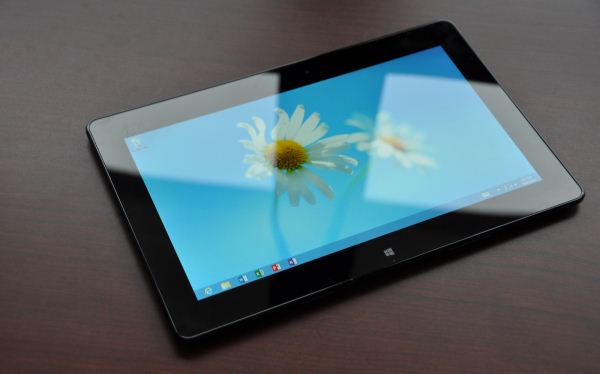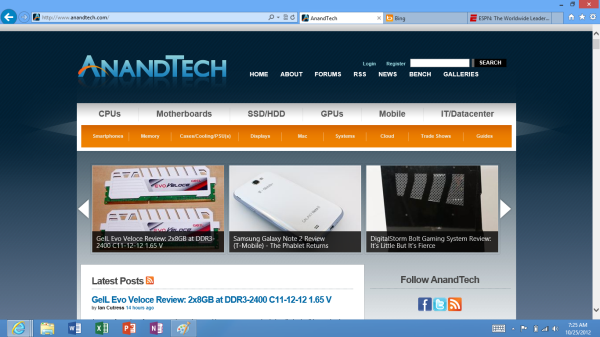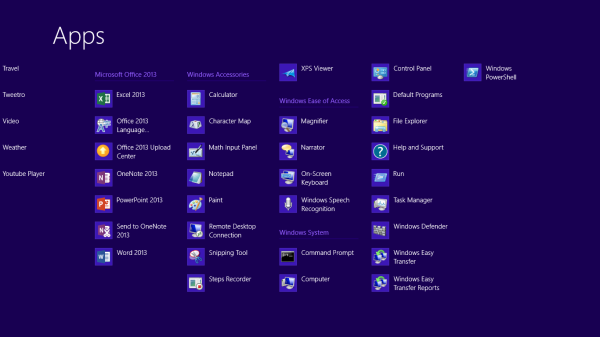The Windows RT Review
by Vivek Gowri & Anand Lal Shimpi on October 25, 2012 12:00 PM EST- Posted in
- Windows RT
- Operating Systems
- Microsoft
- Mobile
- Windows 8
- Tablets
Bridging the Gap, the Dichotomy of Windows RT
by Anand Shimpi
I described Windows RT as being a tablet OS with all of the underlying Windows-ness of Windows. You can get the big full screen app experience in tablet mode, but poke around your file system with Explorer or use Office 2013 like you would on a traditional notebook if you want to. If the two sides of Windows RT remained fairly separate that’d be one thing, unfortunately there are some dependencies between the two sides of the OS that keep the overall user experience from being as friendly as it is in iOS. There are still occasional reminders that you’re dealing with something that’s distinctly Windows here.
Most mobile OSes have done their best to hide the underlying file system and shell from the end user. Microsoft did, in my opinion, the smart thing and avoided hiding its roots with Windows RT. Although the new Start Screen is the default UI for Windows RT, there’s a big desktop tile front and center that will take you back to something far more familiar:
Unlike the Windows 8 desktop, you’re pretty limited in what you can do here. The only applications that are allowed to run in desktop mode under Windows RT are Explorer, IE10, Office 2013 and the command prompt (there are also all of the Windows specific tools and settings which I’ll get to shortly). Developers cannot make applications for Windows RT desktop mode and you can’t sideload anything here. Microsoft’s belief is that by completely locking down the system, requiring that applications only come from the Windows Store, it can avoid the pitfalls of viruses and malware that can plague Windows machines today.
Steve Sinofsky famously quoted an analyst when they asked if Windows RT would be backwards compatible with all of the legacy Windows viruses and spyware. The answer was an astounding no, and this is exactly why we can’t have open season on Windows RT desktop development. There’s also the obvious financial angle to all of this. Microsoft takes a cut of any apps sold through the Windows Store.
Coming from the perspective of a traditional Windows user, the lack of flexibility on the desktop seems wrong. From the perspective of the rest of the ARM based tablet space, it’s not a big deal. At least Windows RT gives you direct, first party access to the file system. There’s very little exposed through iOS, and with Android you need to download a third party app to get access to the file system.
Explorer works just as it would on a Windows 8 PC. The folder structure is exactly as you would expect it on any Windows machine. There are even some x86 remnants in the Windows RT install such as a C:\Windows\SysWOW64 directory complete with x86 binaries inside that obviously won’t run on your Windows RT tablet.
Internet Explorer in desktop mode works just like a traditional IE windows application would work. The desktop app actually controls settings and features for the Metro...err...fancy IE10. For example, if you want to change security settings, clear your history or empty your cache, you have to do all of these things from the IE10 desktop application. Fancy IE10 doesn’t expose them.
The command prompt is, well, a command prompt. It features all of the same commands that you could run before, although once again you can’t simply drop an x86 exe on your system and run it. Not having binary compatibility can be frustrating at times.
Although developers can’t build applications for Windows RT’s desktop, you can write and execute batch files. Keep in mind that if your batch file needs any additional support files (e.g. sleep.exe) you’ll need ARM versions of them which, unless they come from Microsoft, just isn’t happening.
As I mentioned earlier, there are a few other things you can run and do in RT’s desktop mode. Control Panel, event viewer, disk management and all of the other administrative tools that you’d expect to come with Windows are present in Windows RT (including regedit). There are also the little apps that Microsoft has always included, which also work in desktop mode (e.g. mspaint, calc, notepad, etc...)
Ultimately Windows RT is an ARM version of Windows with tablet makeup on. You still get all of the normal bits and pieces of Windows, minus some flexibility and of course, backwards compatibility.
For years we’ve been asking Microsoft to make a clean break with its legacy code and introduce a version of Windows that was built from scratch, with only support for the latest hardware. With Windows RT, Microsoft finally delivered some of that, but in a sort of weird, backwards way.
As Windows RT only supports the ARMv7 instruction set architecture, none of your old x86 applications will run on the platform. Microsoft hoped to avoid this being a problem by shipping an ARM version of Office 2013 Home & Student Edition with Windows RT tablets, and by directing users at the Windows Store for the rest of their application needs. Although it would’ve been possible for Microsoft to enable x86 compatibility through emulation or binary translation, performance would’ve likely been pretty bad.
The loss of backwards compatibility with years of Windows applications feels wrong, but from Microsoft's perspective you don't get that with iOS and Android so there's no real competitive disadvantage here. Why bother with an ARM based version of Windows to begin with? To bring competition to Intel and ensure that it will be able to deliver Windows to the new wave of ultra mobile devices (e.g. tablets). Intel hasn't been competitive on power or pricing at the low end (read: Atom) of the spectrum for years now. The introduction of Windows RT changed that. Atom Z2760 (Clovertrail) is around half the price of the cheapest Atom CPU of the past five years, and it's price competitive with solutions from Qualcomm. We have Windows RT to thank for that. Without pressure from ARM, Clovertrail would've started around $50 per chip just like Intel's low end parts had in the past. As AMD is no longer a pricing check for Intel in some of these new markets, Microsoft had to look for a new way to offer balance. Supporting ARM is its way of doing that. Until there's a new pricing/power/performance x86 competitor to Intel in tablets, ARM and Windows RT will remain.














233 Comments
View All Comments
othercents - Thursday, October 25, 2012 - link
I really wish you could have looked closer at Live Messenger and specifically Video. My parents use Live Messenger since it is easy for them and so do most of the people I know internationally. Skype is a great application, however for them it isn't easy or familure. This is why I continue to need Live Messenger while still using Tango for most phone to phone calls. The best option would be to have Live Messenger Video available on my WP7, but it is just chat and even then some messages just don't get through.Alchemy69 - Thursday, October 25, 2012 - link
If they were going to release on OS specifically for the tablet market why bother including Metro with Windows 8 when it is so obviously geared for touchscreens?Spivonious - Thursday, October 25, 2012 - link
Honestly, the Metro UI is not that hard to use with a mouse.karasaj - Thursday, October 25, 2012 - link
I don't know why people find metro so weird - instead of having a ~90*400 or whatever pixel menu that gives you 10 programs to select, you have all your programs, and you can STILL just type away and the search function works exactly as it does in win7, you don't actually have to type anything extra.Windows key + calc + enter would still bring up the calculator, for example.
Vivek and Anand got it right imo - think of it as a glorified start menu.
ludikraut - Thursday, October 25, 2012 - link
While it's not hard, per-se, to me it feels awkward with a mouse, but just about perfect on a touch screen. IMO the icons are way too large for desktop mouse use - especially when you're used to hitting 1/4" icons on a 40" screen. :-pl8r)
Penti - Thursday, October 25, 2012 - link
You could always use a touch mouse like those from Microsoft, they are just not doing anything to promote it or it's usage scenarios i.e. gestures via mouse or trackpad. Capactive touch on a notebook-formfactor does nothing really so I don't get why they just don't turn to gestures, Apple handle that fine. With a touch mouse you can get all the Windows 8 functionality even if they assume you use fingers. Like charms, switching apps, app commands, scroll left to right and so on. But the MS Touch Mouse is also a 80 dollar device which ships with no systems.So sadly they fail to grasp how users will use these systems. Even though they do promote keyboard and multi-touch trackpad with the Surface. You really understand why major companies, component suppliers and OEM's are wary when it's an unpolished mess. I get why they try to target touch, just not why they try to just fill that space by putting an separate environment on top of the other and keeping them as separate ecosystems which are very hard to move between it's easier to port to an entirely different system which isn't an abstraction of Win32! If you don't innovate with gestures and new navigational features across the whole system it just seems stupid. You quickly get ten ways to do the same thing also. It would have made more sense if it didn't try to be Windows.
Dorek - Friday, November 2, 2012 - link
New Windows 8 machines have touchpad gestures that mirror the on-screen gestures. It's up to trackpad manufacturers to update their drivers to support gestures on older devices, but I assume many of them will.Da W - Thursday, October 25, 2012 - link
I think people underestimate the numbers of apps we're likely to see in the future. Windows phone 7 library grew to over 100000 apps despite having miserable number of units sold in the market. We will see more surface tablets and Windows 8 computers sold in the next 3 month than Windows Phone 7 ever has. The market for developper is there.Consider also the languages being supported here. You know C#, VB.net, Java, HTML5, you can do a metro app. I guess many Windows software can be recorverted to metro relatively easily. I'm not a developper, i'm just a geek and an economist, but i think Microsoft has the most developper-friendly environment out there. And many, many webservices like netflix, facebook, pulse will have a metro app down the road. Many, many iOS / Android apps are little more than rebagadged web pages after all. So you will see them on Windows 8/RT, and even more, the existance of these apps, like netflix being i think more beautiful in Metro than in a web browser, will become a reason for people to upgrade to Windows 8.
Sure the era of Microsoft monopoly over computing devices is over. But there are today some 1.3 billions PCs out there versus 100million iPads, the battle is not over by a wide margin.
That being said, i'm still waiting for my Haswell tablet with a Wacom digitizer.
Spivonious - Thursday, October 25, 2012 - link
You would want to redo the UI to work better with touch, but all of the backend code can stay exactly the same.I think we'll see the marketplace explode with Win8 apps, especially if sales continue to be good.
ludikraut - Thursday, October 25, 2012 - link
You're spot on. App development for Metro is about as easy as it gets. Much easier than IOS, IMO.Ditto for waiting on a Haswell tablet with Wacom digitizer.
l8r)